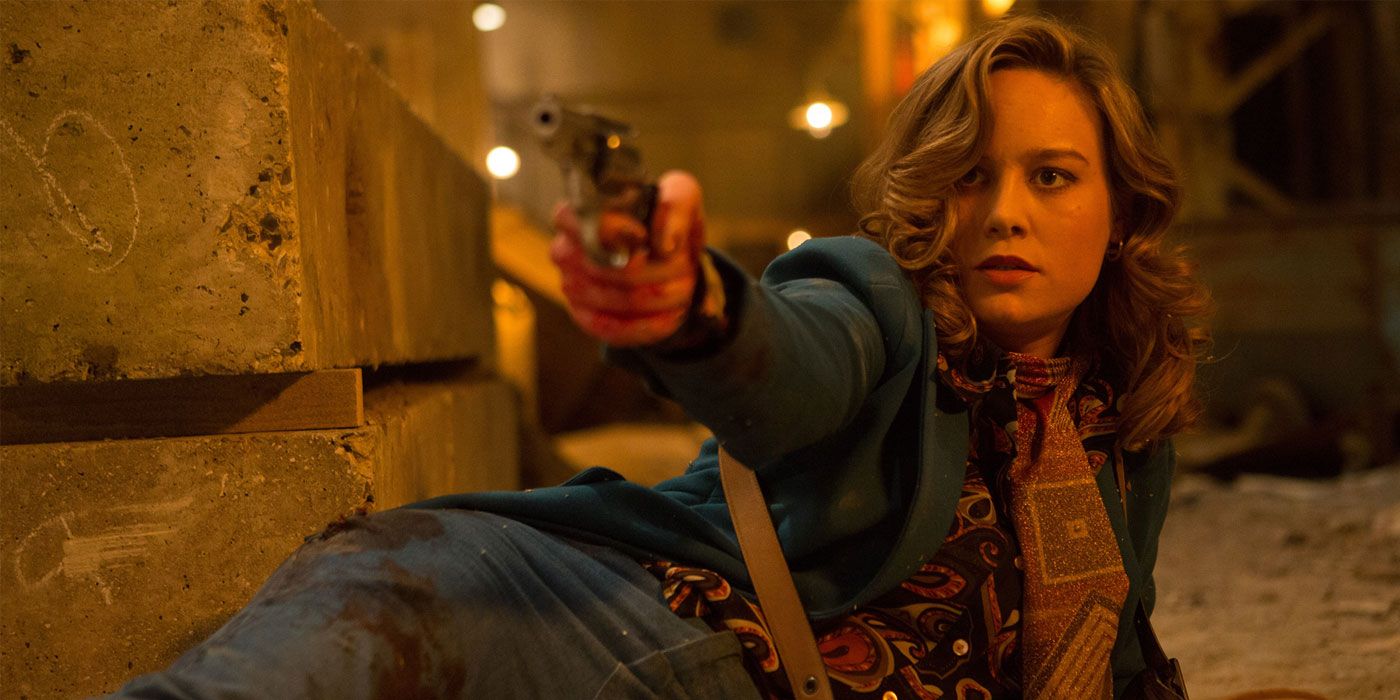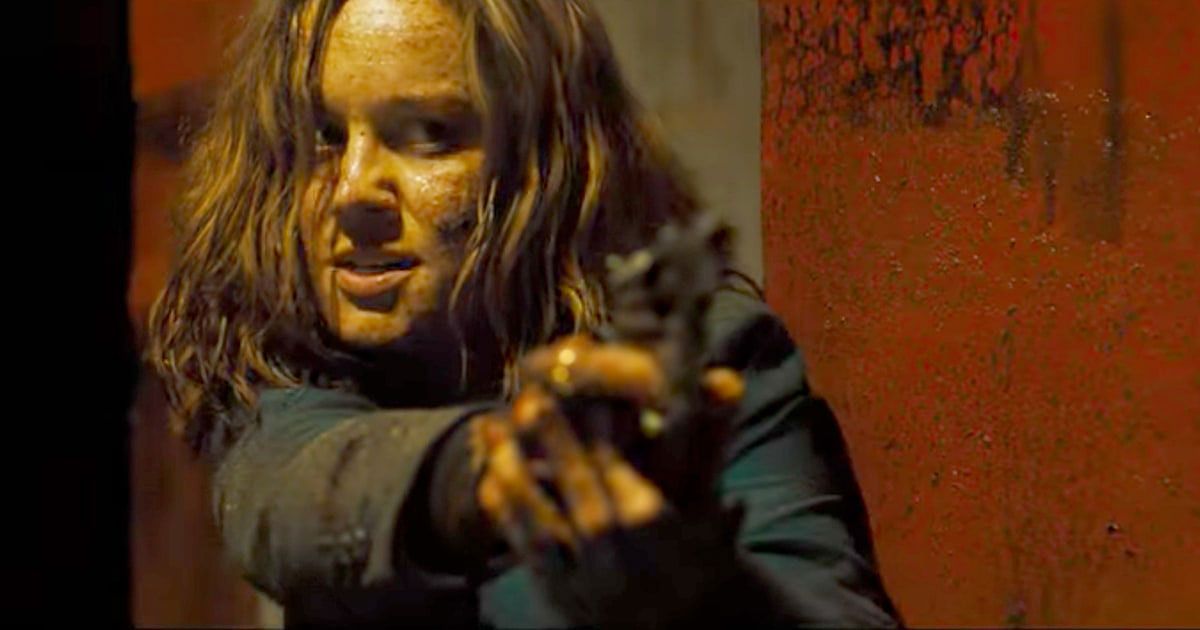Brie Larson’s career is as hot as a recently fired pistol.
After her Academy Award-winning turn in the harrowing drama “Room,” the 27-year-old actress has been sampling a string of new genres, from co-starring opposite a monster movie icon in the recent blockbuster “Kong: Skull Island” to her upcoming stint as a superheroine in Marvel Studios’ “Captain Marvel.” In between, she took a turn for the quirkier in the farcical, high-caliber action comedy “Free Fire” from filmmaker Ben Wheatley (“High Rise”).
RELATED: Captain Marvel’s MCU Costume Described
Set during the 1970s in the single location of a warehouse – “Just slightly bigger space than ‘Room,’” she told CBR with a laugh – an illicit arms deal takes a decidedly bullet-riddled turn. Larson plays the relatively cool-headed but non-marksman-like midddlewoman Justine, opposite a collection of gun-toting co-stars including Cilian Murphy, Sharto Copley, Armie Hammer, Sam Riley and Jack Reynor.
And, as CBR learned in a series of conversations with Larson, the actress is all for embracing the down-and-dirty thrills of her action movie run – but when it comes to Captain Marvel, she sees herself as primarily being responsible for what’s happening inside the character’s head.
On going to work with an ensemble right after the close quarters of “Room”:
Brie Larson: That’s an interesting question. I think for me, I always like to feel a little bit uncomfortable in every film that I make. That’s why I always switch between genres and play very different types of characters. I like to feel a little contrapposto in whatever it is I’m doing. If everything becomes too routine, I think you get a little stale.
What’s interesting about this film is that we shot it in order, and a lot of the time we didn’t quite know what was going to happen next. Ben had really meticulously planned out all of the action, because it’s very action-driven within this one space. Then there are certain things that would happen unexpectedly.
I remember in particular Ben saying, “Okay, you need to run from this part of the warehouse to the other part,” and Jack [Reynor] was like, “Well, I would get you – I would shoot you if you did that.” “Okay, well then you get shot again.” What?
So it was like playing this really long game of laser tag. We were just such a little family. It was one of my favorite experiences.
On being an action movie hero:
I don’t think that being part of action was my reason for doing this. It’s just whatever the story under the story is.
This was the first physical role that I ever did. Exploring that in itself, dragging myself across a floor for a month... Well, I haven’t done that and I don’t know if I ever will again. It’s really hard! The action element of what I’d done before was really mental and very emotional. This was the opposite.
Ben’s whole objective every day was that we were always super confused so that we didn’t know what was going on. It wasn’t about crafting some sort of perfect performance. It was about throwing it all out the window and being panicked and confused.
On her character's particular sense of '70s style in the film:
She doesn’t have money. She doesn’t come from money, so this piece of clothing is the nicest thing she owns that she probably stole for this one deal to make it seem like she’s really amazing. It’s just for show. The dudes are really the ones that are the peacocks. She’s actually playing it down. She wants them to feel like they are the most powerful and amazing because it puts them where she wants them.
On the dirt she found in unexpected places while filming "Free Fire":
[I got it] everywhere – especially later in the movie once it gets wet. Once it becomes mud, it brings a whole other layer of just feeling gross. I think we all know what that feels like. This was like a whole new level of stench. And it’s the same clothes. One pair of clothes we shot in order, every single day, that’s slowly getting blown-up and more fake blood and more fake dirt.
One of my favorite memories is Ben saying, ‘Okay, everybody get in your positions,’ and everybody went to their part of the warehouse and watched all of us start rolling around on the ground to get covered in dirt to match everything else we’d done. It’s such a weird thing to see – a group of ten people all rolling around in dirt, doing dirt angels on the ground to try to get ready to shoot.
On her personal comfort level with firearms:
I didn’t like it. But that’s part of the job, putting yourself in uncomfortable situations and I don’t think my character is supposed to be particularly good at holding a gun. I don’t think I realized how uncomfortable I was with it until I started shooting the film that it’s a piece of equipment I feel awful holding in my hands. It feels like I shouldn’t be near it.
On the sound of gunfire on set:
We went through a lot of earplugs. The bottom of my bag in the movie was completely covered in wax. We were constantly putting them in and taking them out. There were earplugs everywhere – all over the floor, in my bag and in my pockets.
On the film’s gun violence and the message behind it:
Movies are like this funhouse mirror reflecting back on society. Watching movies was how I learned about different parts of the world. It’s how I learned about different periods of time. It’s not until I’ve gotten older where I was like, “It’s not history. Movies are not history.” They can give us a flavor of it but it’s told through the eyes of an individual, of an idealized world. Ben’s response to that is “How can we make this what it actual is, which is not glorifying this at all, showing how ridiculous the whole thing is?”
The first time I watched the movie, I remember being about 45 minutes in and I was laughing, but was like, “Why is this happening?! Why is everyone still in this room?!”’ Just one person has to go, “Hey! I don’t wanna do this anymore,” and they walk out.
I have my reasons for wanting to explore this as something that’s part of culture and something that’s part of the industry that I’m in. On the side of being a woman, it’s been important for me to say, “Guess what? We’re lots of different ways and I’m going to do my best to show all the different sides that I can portray that, I hope, other women pick up where I’m leaving off because I can’t do it all.”
It’s the same thing with genre and the way we’re objectively looking at things. Being part of films that say, “That doesn’t really look the way that we’ve maybe done it before” – that’s how we continue to improve and that’s how my industry continues to improve.
On building towards the physical element prep for “Captain Marvel”:
Anything that’s the physical side, from past experience, you hire specialists to help you understand that and quantify it and pace you out and figure it all out. That’s part of the fun of making a movie. There’s a person who does the focus-pulling, and they’re the specialist at understanding depth. They do something I don’t understand, and I do something they don’t understand.
My main focus is more on the human side of it. The costumes and all the stuff that’s on the surface, there are people you should talk to that are really interesting and they’re the ones in charge of that part. I’m just in charge of what’s going on in her head.
On her comic book research for “Captain Marvel”:
It’s always for me about the complexity. The thing that I love about her is that there are these actually two sides to her – these two things that are at war with each other. I feel like that’s what I love about being a person is that we’re constantly trying to balance between these two sides of ourselves, or many sides of ourselves. It’s such an amazing opportunity to be able to put that metaphor on the outside and make that part of what her conflict is.


